Looking for top IT documentation tools? Here's a quick rundown of the best options for 2024:
- ProProfs Knowledge Base
- Scribe
- Document360
- HelpNDoc
- ClickHelp
- KnowledgeOwl
- Confluence
- Notion
- Read the Docs
- Sphinx
These tools stand out for their ease of use, features, and ability to streamline IT documentation.
Key trends shaping IT documentation software:
- AI-powered writing and checking
- Cloud-based systems for anywhere access
- Mobile-friendly interfaces
- Rich media integration (videos, interactive content)
Quick Comparison:
| Software | Best For | Standout Feature | Price Range |
|---|---|---|---|
| ProProfs | Small-mid teams | Easy setup | $0-$199/mo |
| Scribe | Process docs | AI-generated guides | Contact sales |
| Document360 | Large projects | Robust search | $0-$399/mo |
| HelpNDoc | Multiple formats | Multi-format output | One-time purchase |
| ClickHelp | Collaboration | Real-time editing | $175-$580/mo |
When choosing, consider:
- Your team size and structure
- Types of docs you need
- Budget constraints
- Existing tech stack
- Ease of adoption
Remember: Test before you buy, get team input, and think long-term.
Related video from YouTube
How we rated the software
We evaluated IT documentation software based on six key areas:
Ease of use
We tested how quickly teams could start using each tool. Docusaurus, for example, lets teams hit the ground running with its no-fuss approach.
Features
We looked at core capabilities like version control, search, and customization. MadCap Flare stands out by offering multiple output formats - HTML, PDF, and Word - giving teams options for sharing docs.
Integration
We checked how well each tool plays with others. SwaggerHub excels here, working smoothly with API development tools and supporting OpenAPI standards.
Scalability
We assessed each tool's ability to grow with your needs. ClickHelp, for instance, works well for both small and large teams.
Security and compliance
Data protection is non-negotiable. DocuWare offers robust security, including data encryption and detailed access controls.
Price and value
We compared costs and features. Here's a quick look at common pricing tiers:
| Plan | Price Range | Typical Features |
|---|---|---|
| Free | $0 | Basic doc creation, limited sharing |
| Basic | $5-$10/user/month | More storage, team features |
| Pro | $10-$30/user/month | Advanced security, full collaboration |
| Enterprise | Custom | Tailored solutions, dedicated support |
When choosing a tool, focus on what your team needs most. Handling sensitive data? Prioritize security. Got a big team? Look for strong collaboration features.
Top 10 IT documentation software for 2024
1. ProProfs Knowledge Base
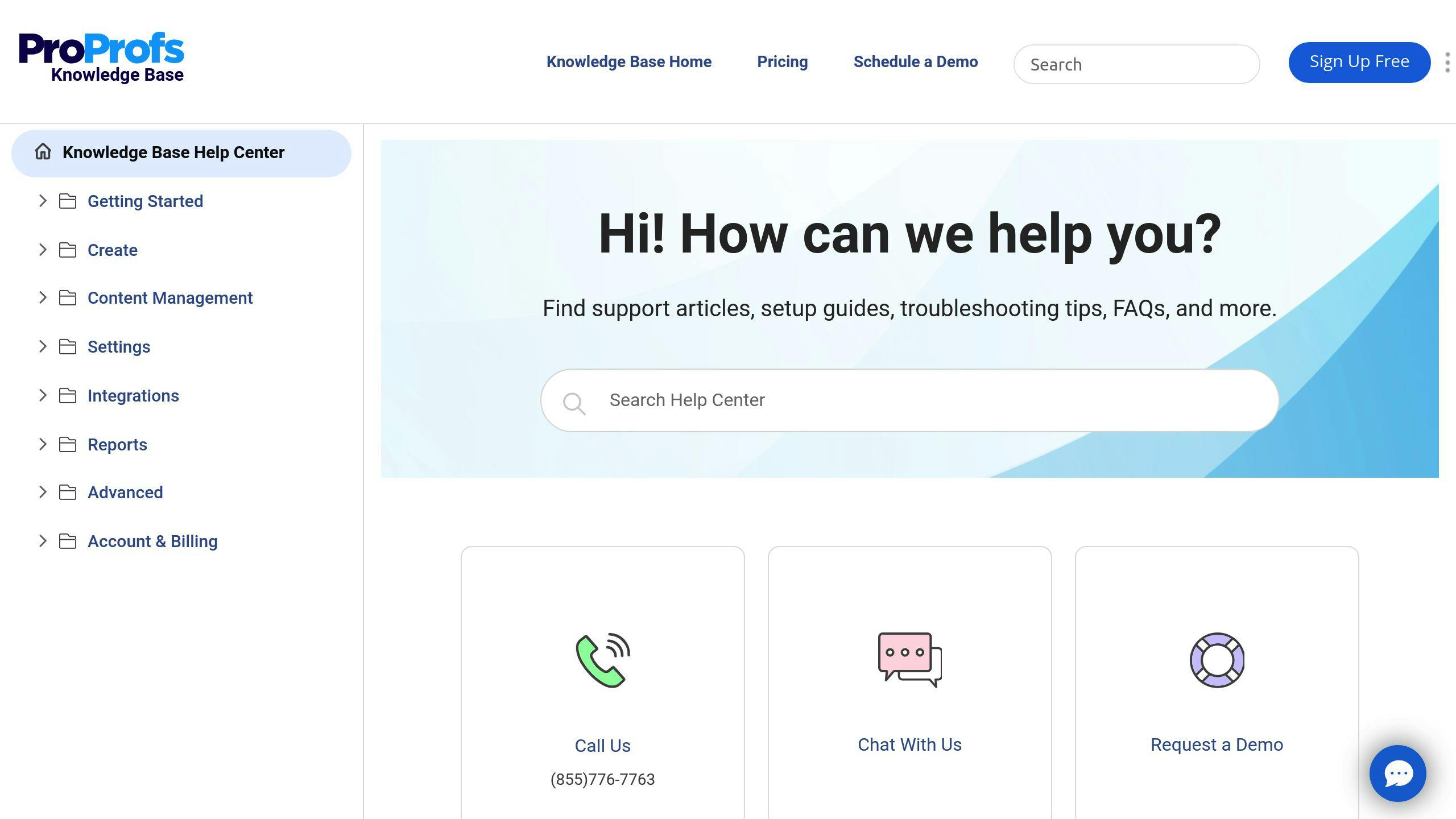
ProProfs Knowledge Base is a user-friendly tool for creating help sites, user manuals, and private knowledge bases.
Key features:
- Customizable templates
- Detailed analytics
- Embedded tooltips and pop-ups
Pros:
- Cuts down on internal IT tickets
- Works with ticketing systems like Freshdesk
- Free for up to 25 articles
Cons:
- Limited customization
- Basic appearance
Best for: Small to mid-sized teams wanting an easy-to-use solution with core features.
"ProProfs Knowledge Base fits perfectly with our Freshdesk ticketing system. It streamlines our ticket management by sending customer requests straight to Freshdesk." - G2 Reviewer
2. Scribe
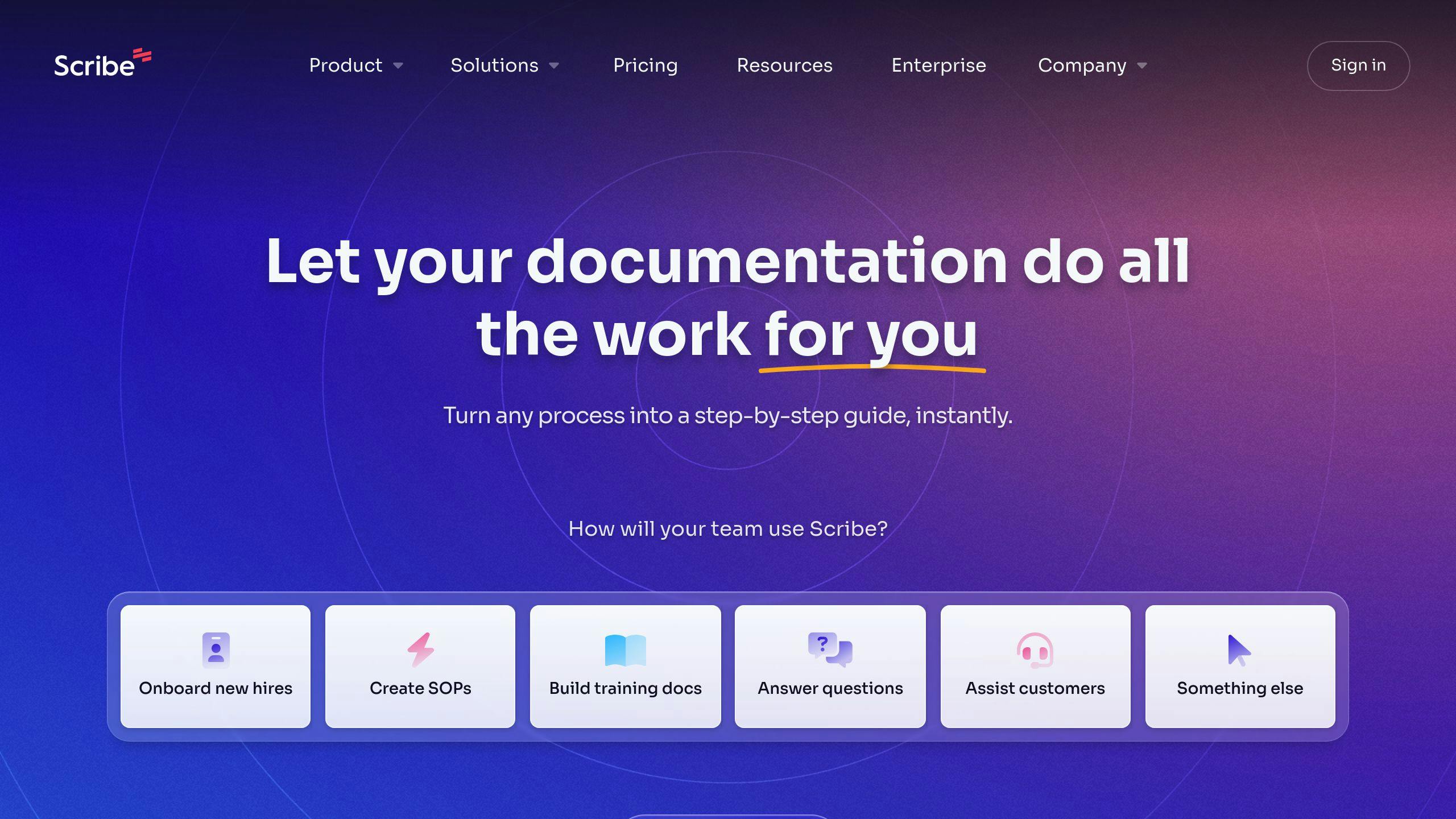
Scribe uses AI to quickly turn processes into visual guides, perfect for teams that often document procedures.
Key features:
- AI-generated step-by-step guides
- Screenshot capture
- AI-powered documentation
Pros:
- Speeds up complex IT procedure documentation
- High user ratings
- Free basic version
Cons:
- May need to tweak auto-generated content
- Limited customization
Best for: Teams needing to create lots of process docs quickly.
"Scribe is my go-to for sharing knowledge across teams. It's super easy to use and saves us tons of time." - Claire Mai C., Product Manager
3. Document360
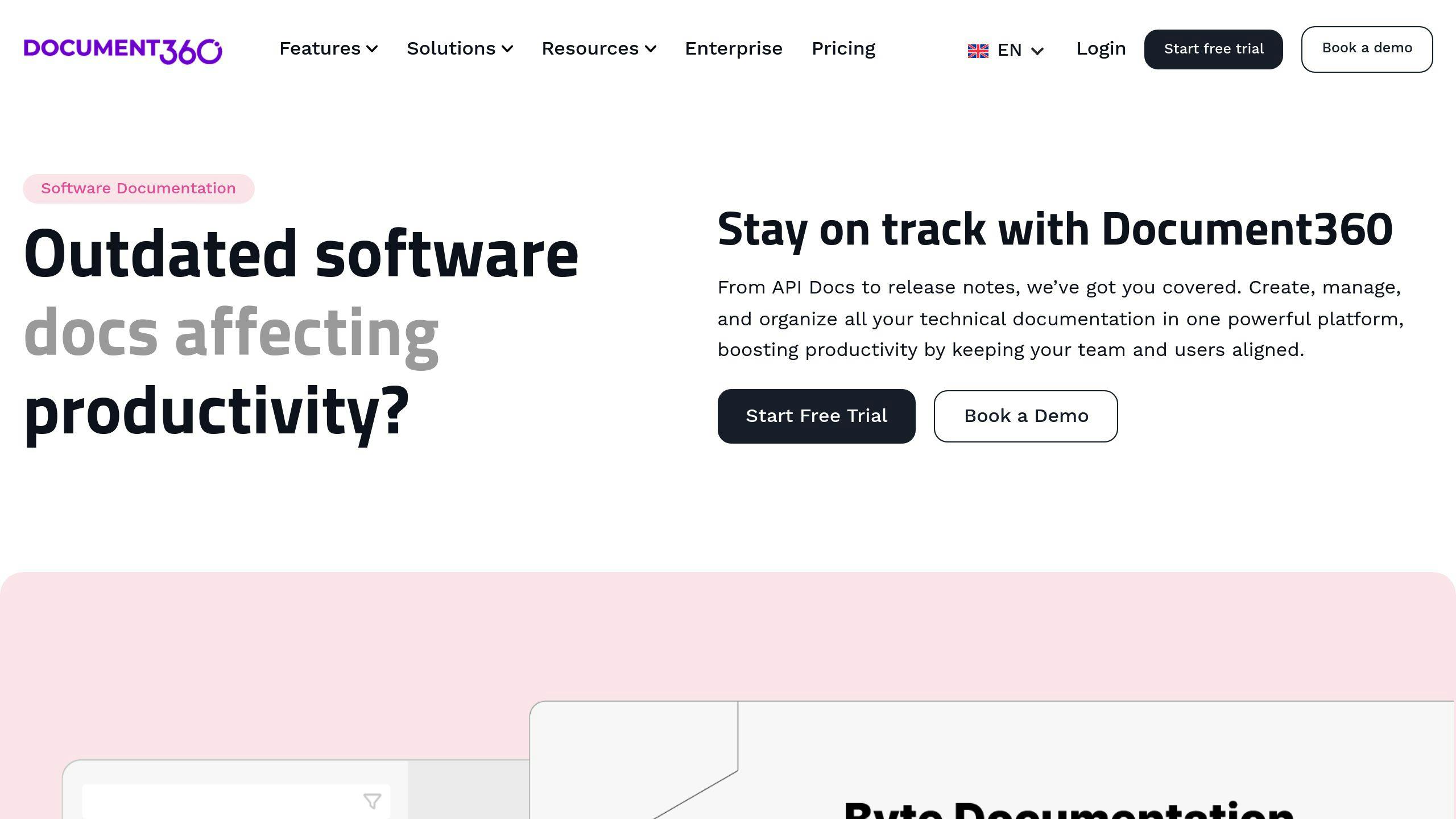
Document360 offers robust search and version control, ideal for large-scale documentation projects.
Key features:
- Real-time search engine
- Version control
- Customizable themes
Pros:
- Fast, context-aware search
- Supports Markdown
- Free plan available
Cons:
- Steeper learning curve
- Pricier for advanced features
Best for: Large teams or companies with complex documentation needs.
4. HelpNDoc

HelpNDoc creates docs in multiple formats, including HTML, PDF, and Word.
Key features:
- Multi-format output
- Built-in spell checker
- Topic organization tools
Pros:
- Flexible output options
- One-time purchase available
- User-friendly interface
Cons:
- Limited collaboration features
- Windows-only
Best for: Small teams or solo technical writers needing various output formats.
5. ClickHelp
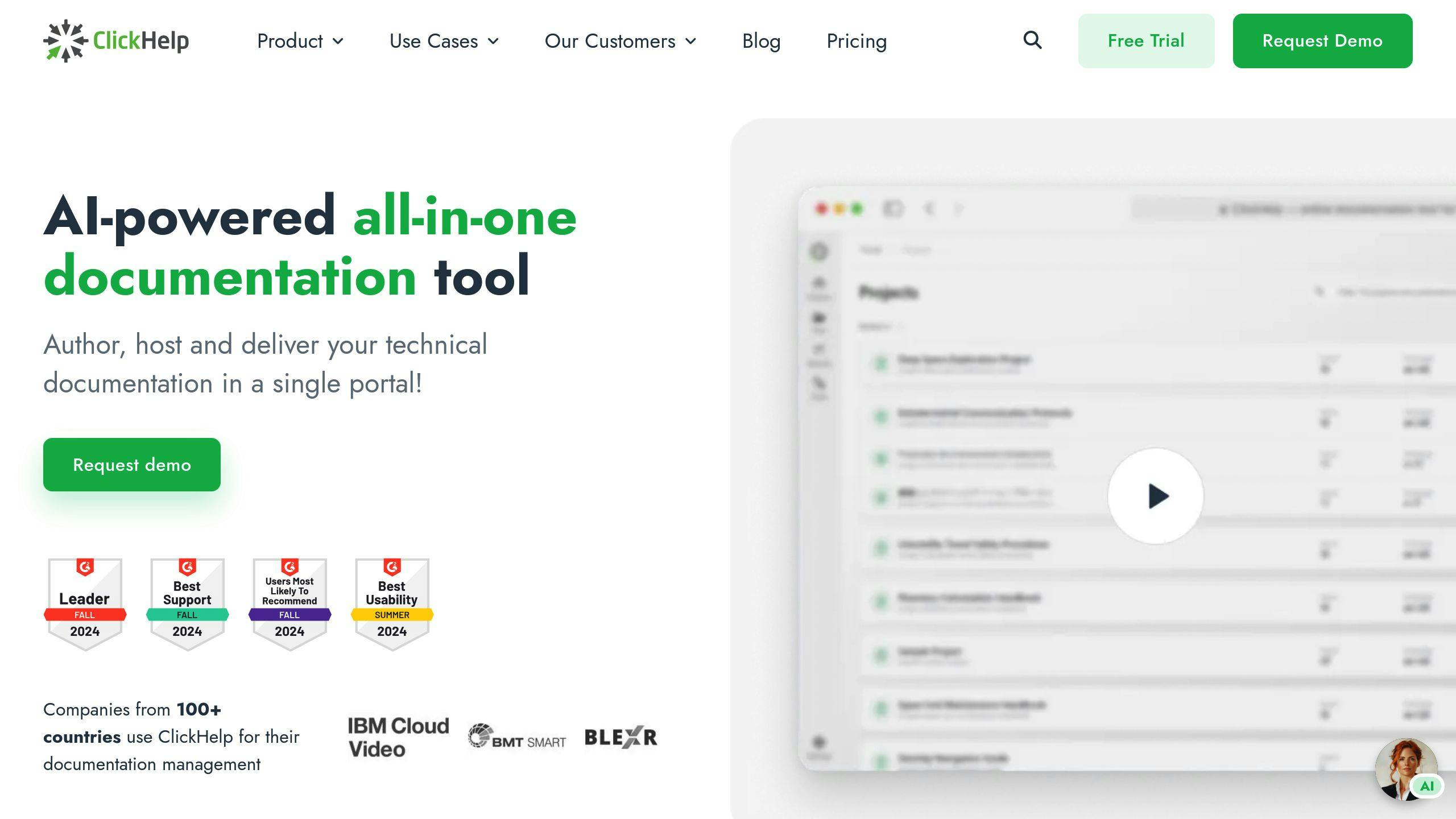
ClickHelp is a cloud-based solution with strong collaboration features.
Key features:
- Real-time collaboration
- Custom branding
- Analytics and reporting
Pros:
- Scales well for different team sizes
- Robust security
- Flexible pricing
Cons:
- Can be expensive for smaller teams
- Steeper learning curve for advanced features
Best for: Medium to large teams needing strong collaboration tools and customization.
6. KnowledgeOwl

KnowledgeOwl offers a straightforward solution for creating and managing knowledge bases.
Key features:
- Custom domain and branding
- Access controls
- Integrated feedback system
Pros:
- Easy setup and use
- Good customer support
- Flexible content organization
Cons:
- Limited integrations
- Basic design options
Best for: Small to mid-sized teams wanting a simple knowledge base solution.
7. Confluence

Confluence, part of Atlassian, integrates well with other Atlassian tools and third-party apps.
Key features:
- Real-time editing
- Extensive template library
- Strong integration capabilities
Pros:
- Works well with other Atlassian products
- Customizable workflows
- Free for up to 10 users
Cons:
- Can be complex for newbies
- Some real-time editing issues reported
Best for: Teams using Atlassian products or needing strong integrations.
"Confluence's wiki features are great. They help new hires quickly learn company knowledge and onboard smoothly." - G2 Reviewer
8. Notion

Notion offers a flexible workspace for various purposes, including documentation.
Key features:
- Customizable workspaces
- Drag-and-drop interface
- Collaborative editing
Pros:
- Highly versatile
- Intuitive UI
- Free plan available
Cons:
- Can be overwhelming due to flexibility
- Limited offline use
Best for: Teams wanting a versatile tool for docs and project management.
"Notion's flexibility is its best feature. It adapts to my needs, not the other way around. I use it for notes, projects, tasks, and as a knowledge base." - G2 Reviewer
9. Read the Docs
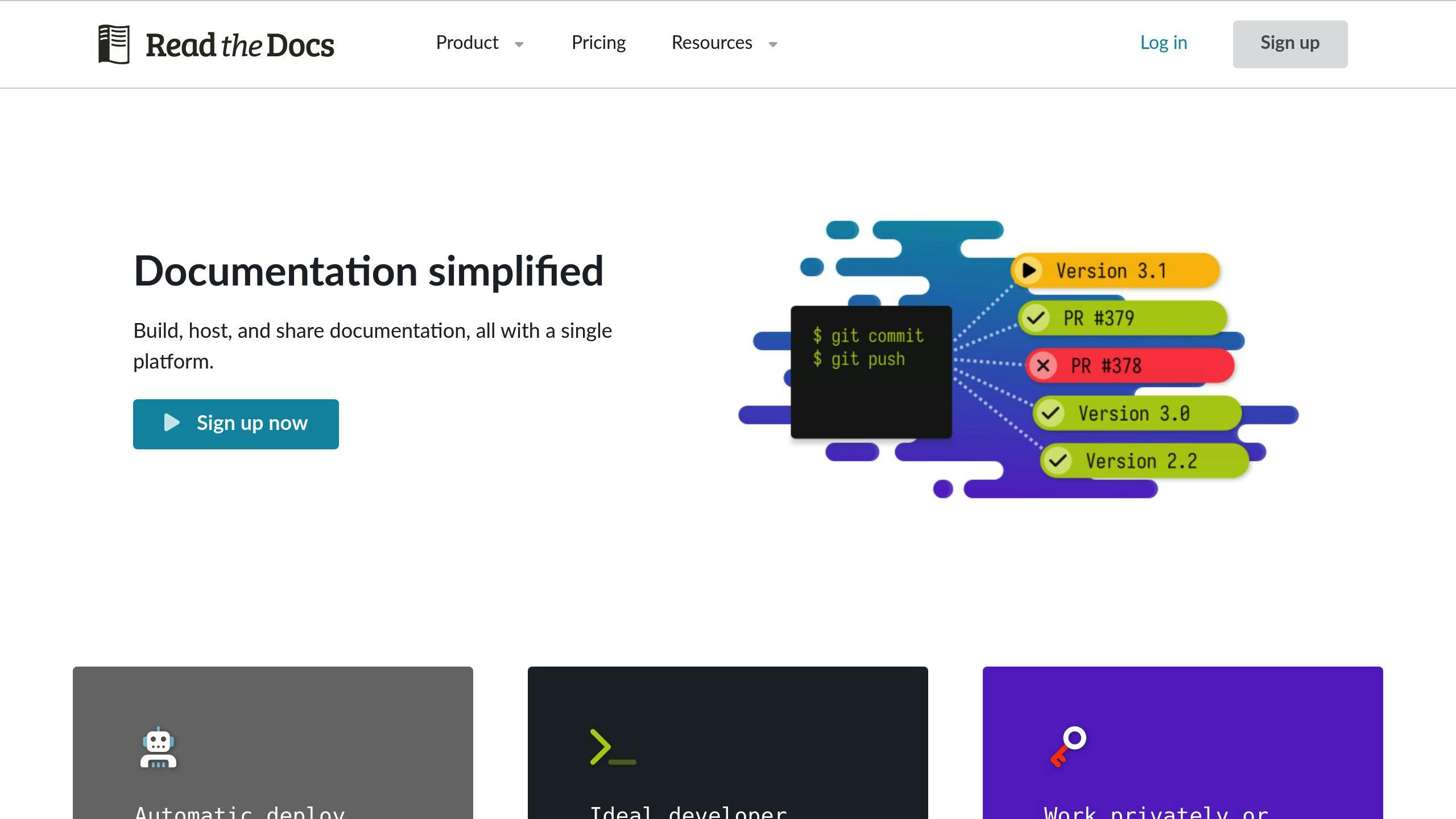
Read the Docs automatically builds, versions, and hosts documentation, popular among developers.
Key features:
- Auto-building from version control
- Multiple output formats
- Full-text search
Pros:
- Free hosting for open-source projects
- Integrates with GitHub and other VCS
- Great for technical docs
Cons:
- Steep learning curve for non-techies
- Limited customization
Best for: Dev teams on open-source projects or needing version-controlled docs.
10. Sphinx
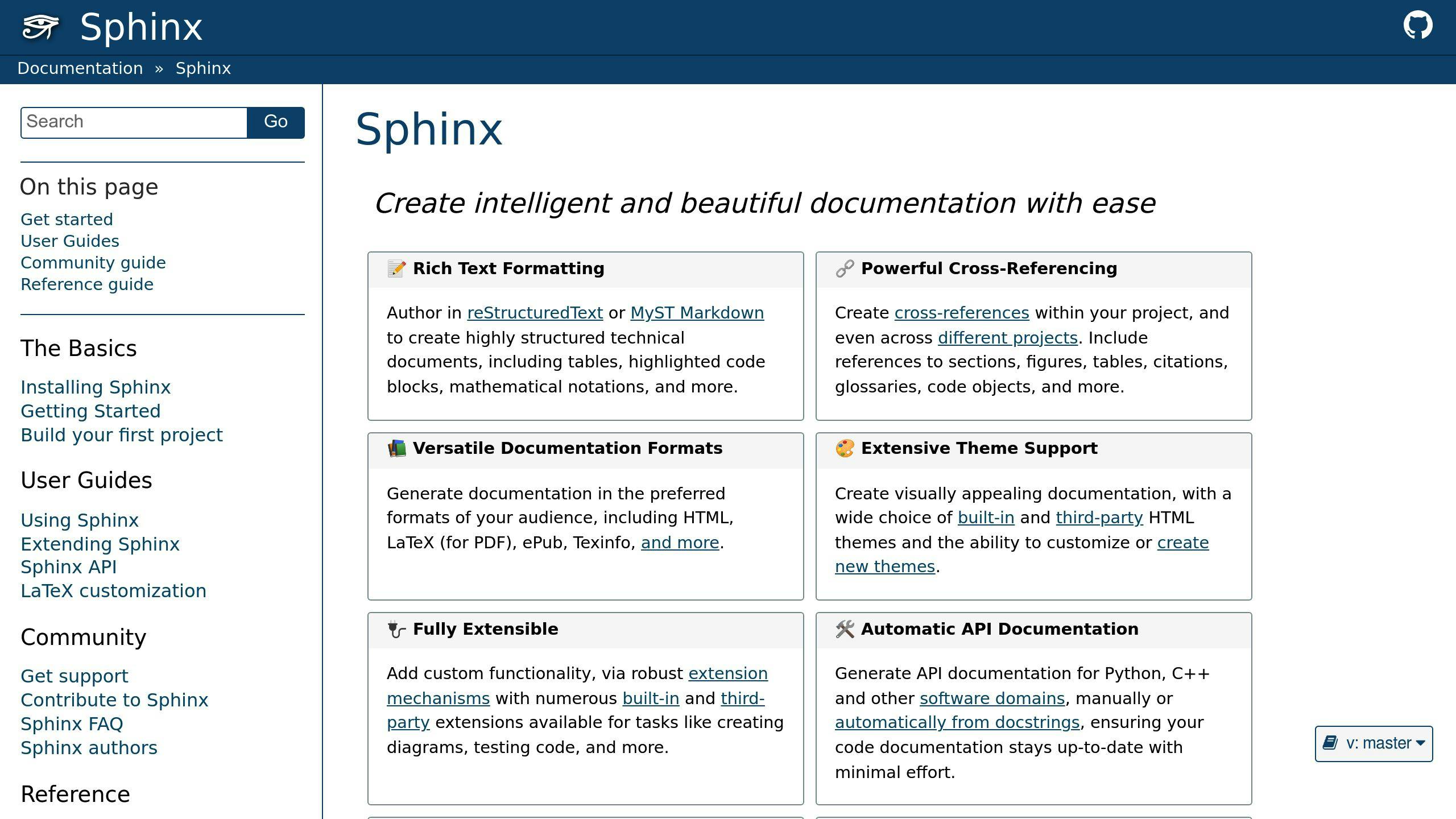
Sphinx is an open-source tool popular for Python docs but works with various programming languages.
Key features:
- Multiple output format support
- Cross-referencing between documents
- Extensible with plugins
Pros:
- Free and open-source
- Strong code documentation support
- Highly customizable
Cons:
- Requires technical know-how
- Limited built-in collaboration features
Best for: Technical teams, especially Python users, needing a powerful, customizable doc tool.
Comparison table
Here's a quick look at the top 10 IT documentation tools for 2024:
| Software | Key Features | Pricing | G2 Rating |
|---|---|---|---|
| ProProfs Knowledge Base | Custom templates, analytics, tooltips | $0-199/month | 4.4/5 |
| Scribe | AI guides, screenshot capture | Contact sales | 4.8/5 |
| Document360 | Real-time search, version control | $0-$399/5 members/month | 4.7/5 |
| HelpNDoc | Multi-format output, spell check | One-time purchase | N/A |
| ClickHelp | Real-time collab, custom branding | $175-$580/month | 4.8/5 |
| KnowledgeOwl | Custom domain, access controls | Contact sales | N/A |
| Confluence | Real-time editing, integrations | $0-$21/license/month | 4.7/5 |
| Notion | Custom workspaces, drag-and-drop | $0-$10/user/month | N/A |
| Read the Docs | Auto-build from version control | Free for open-source | N/A |
| Sphinx | Multiple outputs, cross-referencing | Free | N/A |
What to keep in mind:
- Pricing: Some offer free plans (ProProfs, Confluence, Notion), others need a call with sales (Scribe, KnowledgeOwl).
- User love: Scribe and ClickHelp top the charts with 4.8/5 on G2.
-
Stand-out features:
- Scribe: AI-powered guides
- Document360: Solid version control
- HelpNDoc: Outputs to multiple formats
- Read the Docs: Plays nice with version control
- Team players: Confluence, ClickHelp, and Notion shine in real-time collaboration.
- Make it yours: ProProfs, Document360, and ClickHelp let you customize like crazy.
Picking your tool? Think about your team size, what kind of docs you need, and what other tools you use. Small team that needs to get going fast? Try ProProfs or Notion. Big org with complex docs? Look at Document360 or Confluence.
sbb-itb-9890dba
What to think about when choosing
Picking the right IT documentation software isn't a one-size-fits-all deal. Here's what you need to consider:
Company size and setup
Your organization's size and complexity matter. A lot.
Small teams (1-10 people)? Notion or ProProfs Knowledge Base might do the trick.
Mid-size companies (11-100 employees)? Look at Document360 or ClickHelp.
Large enterprises (100+ staff)? You're in Confluence or custom solution territory.
What you need to document
Different teams, different needs:
- IT teams need tech docs with code snippets and API references.
- HR focuses on policy docs and employee handbooks.
- Customer support? They want easy-to-update knowledge bases.
Money limits
Budget can make or break your choice:
| Price Range | Options |
|---|---|
| Free - $10/user/month | ProProfs Knowledge Base, Notion, Read the Docs |
| $11 - $50/user/month | Document360, Confluence |
| $50+ /user/month | ClickHelp, custom enterprise solutions |
Working with what you have
Your current tech stack matters:
- Using Atlassian? Confluence might fit right in.
- GitHub user? Read the Docs could be your jam.
- Microsoft-heavy? Look for strong Office integration.
How easy it is to start using
Think about the learning curve:
- Notion or ProProfs? Quick to pick up.
- Sphinx? Might need some training time.
Look for good docs and support to make adoption smoother.
Special needs for different industries
Healthcare, finance, and manufacturing each face unique IT documentation challenges. Let's explore how they tackle these issues.
Healthcare IT docs
Healthcare orgs juggle patient data and strict rules. Their IT docs must be:
- HIPAA-compliant
- Easy for authorized staff to access
- Up-to-date with changing regulations
Take Freed AI, for example. It cranks out HIPAA-compliant notes in just 60 seconds. This means docs can focus on patients, not paperwork.
Financial services rules
Banks need solid documentation to stay on the right side of laws like Dodd-Frank and the Bank Secrecy Act. Their IT docs should:
- Track every financial move
- Leave a clear audit trail
- Lock down data security
Many firms use special compliance software for this. These tools often include:
| Feature | Purpose |
|---|---|
| Auto-reporting | Spits out required regulatory reports |
| Rule breach alerts | Flags potential violations |
| Transaction logs | Keeps detailed records of all activities |
Factory and shipping docs
Manufacturing and logistics companies need docs that keep their complex operations running smoothly. Key points:
- Step-by-step process instructions
- Quality control procedures
- Supply chain tracking
SiteDocs, a cloud platform, helps big names like Lafarge and Clayton Homes manage their docs. It turns paper into digital records, so teams can grab info from anywhere.
For manufacturers, good documentation is crucial for:
1. Staying on the right side of regulations
2. Keeping operations consistent
3. Backing up quality control efforts
As industries go digital, solid IT documentation becomes even more important. The winning tools will handle industry-specific needs while keeping things user-friendly.
What's next for IT documentation software
IT documentation software is evolving rapidly. Here's what's on the horizon:
AI and machine learning
AI is revolutionizing documentation:
- Scribe auto-generates step-by-step guides as you work
- DocuWriter creates API docs directly from your code
- Bito AI keeps docs synced with code changes
But AI isn't perfect. It can miss nuances or produce generic content. That's why skilled writers are still crucial.
Automation
Automation is speeding things up:
| Task | Change |
|---|---|
| Data capture | AI-powered OCR extracts info from scanned docs |
| Categorizing | Algorithms sort and tag documents |
| Updating | Systems flag outdated info |
The IT process automation market is set to double from $9.8 billion in 2020 to $19.6 billion by 2026.
Collaboration tools
New tools are enhancing teamwork:
- Real-time editing for multiple users
- Version control to track changes
- Cloud access from anywhere
A McKinsey study found good collaboration tools can boost productivity by up to 30%.
Future trends:
- AI assistants answering doc-related questions
- Video-based support for visual learners
- Scenario-based searches instead of keywords
The end goal? Making info easier to find and use for everyone.
Wrap-up
Let's recap the top IT documentation software and key points:
Top Picks:
- ProProfs Knowledge Base
- Scribe
- Document360
These tools shine in usability, features, and integrations.
Key Points:
- AI is changing the game (Scribe auto-generates guides)
- Cloud storage is now standard
- Automation is a must-have
Choosing Your Tool:
| Factor | Why It Matters |
|---|---|
| Company Size | Scalability needs |
| Doc Type | Feature requirements |
| Budget | Affordability |
| Existing Tools | Integration needs |
| Ease of Use | Adoption rate |
Industry Needs:
- Healthcare: HIPAA compliance
- Finance: Strong security
- Manufacturing: Visual tools
The IT documentation software market is growing. Gartner expects 12% annual growth in enterprise software through 2026.
Quick Tips:
- Test before buying
- Get team input
- Think long-term
FAQs
What is system administrator documentation?
System administrator documentation is a guide that covers the key parts of an IT system. It's like a roadmap for IT pros to keep things running smoothly. Here's what it usually includes:
- System overview and purpose
- Main features
- Hardware and software needs
- Network setup
- Security measures
- Dependencies
This documentation helps admins maintain, fix, and improve the system's performance and security.
What is knowledge base software?
Knowledge base software is a tool for creating and managing an online info library. It's used for:
- Internal stuff (for employees)
- External stuff (for customers)
Here's how internal and external knowledge bases differ:
| Aspect | Internal | External |
|---|---|---|
| Users | Employees | Customers |
| Content | Company policies, training materials | FAQs, product guides |
| Benefits | Better info sharing, helps remote work | Happier customers, less support costs |
This software makes it easy for people to find answers quickly, whether they're staff or customers.


